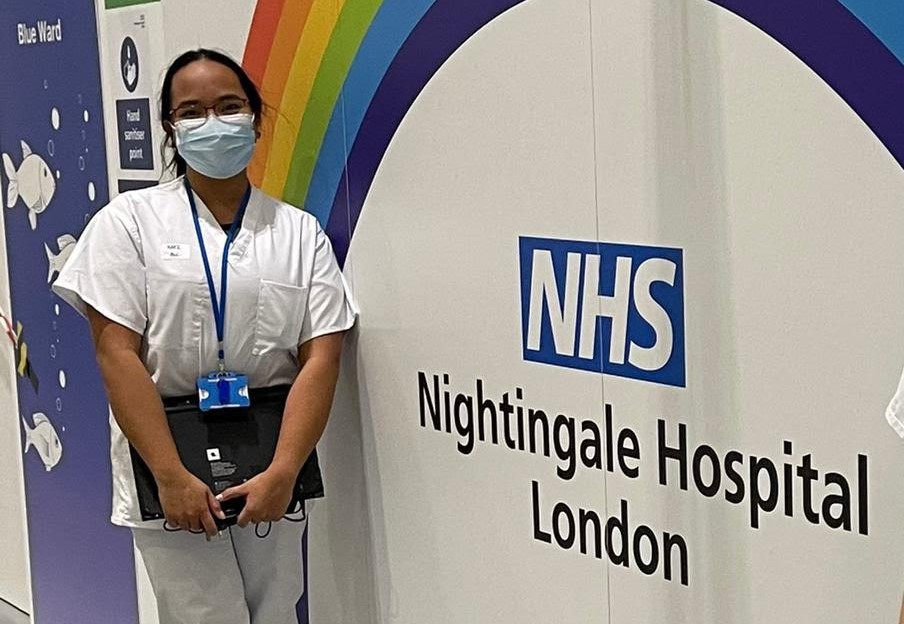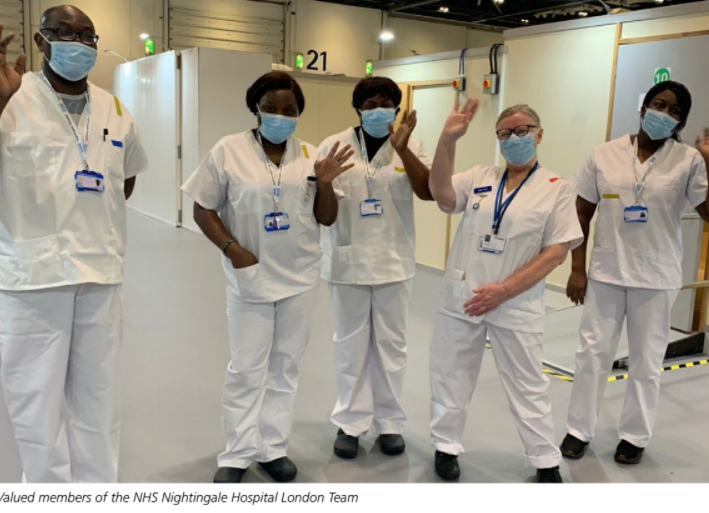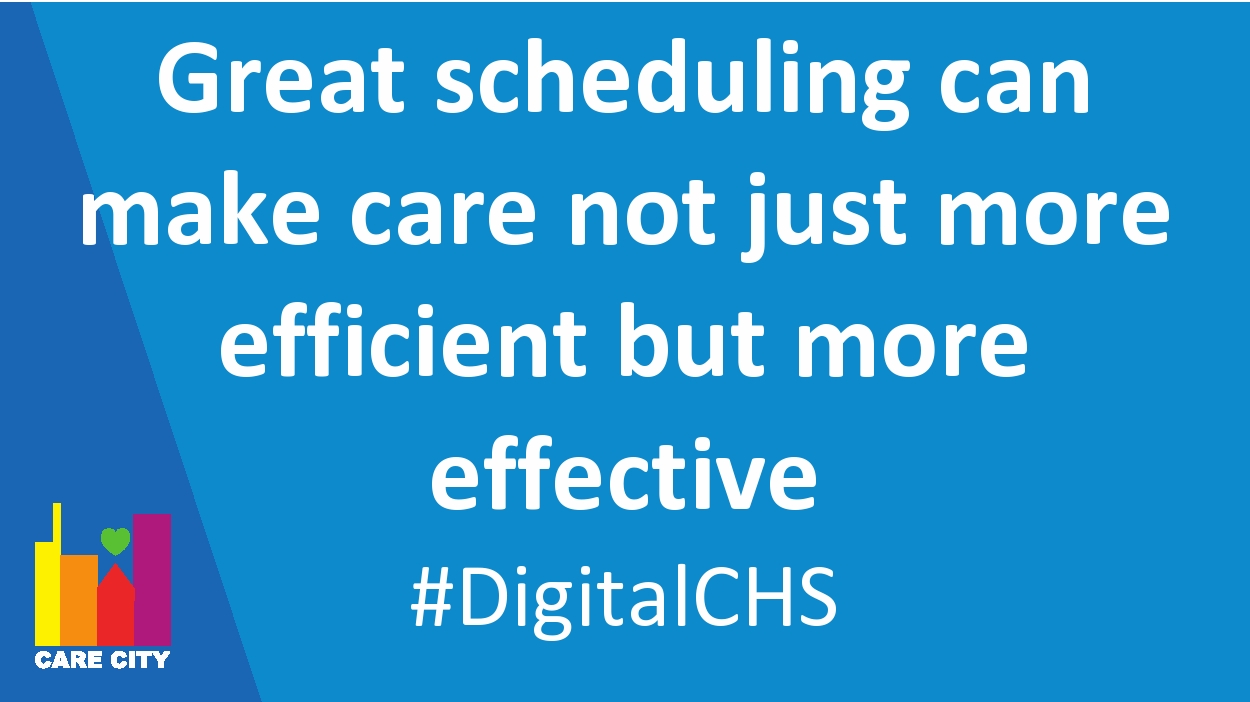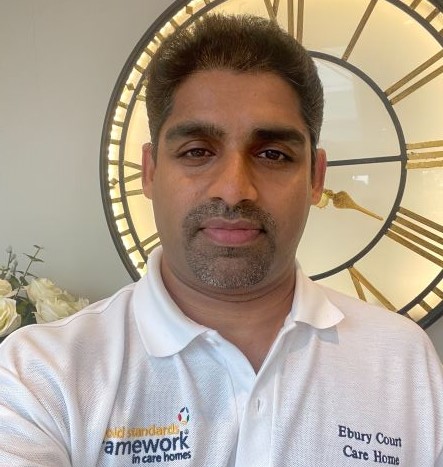The beginning of 2021 saw Hannah Harniess our Deputy Chief Exective seconded to the Senior Clinical Leadership Team at Nightingale Hospital London. You can read her story here…
The Covid-19 pandemic has forced us all to rapidly learn and to rethink how we interact with and deliver health and care services. In January 2021, as the pressures on London hospitals once again escalated, I was seconded to NELFT as part of the senior clinical leadership team tasked with establishing a second Nightingale Hospital London (NHL2).
It was one of my most challenging, exhausting and rewarding roles. However, my story isn’t remarkable or unique. There are a million stories of people stretched beyond their role, who’ve supported people with Covid-19 at their most vulnerable, going above and beyond to try to keep families connected to their loved ones.
Many of the workforce have not only had to rapidly learn about this novel virus, but also learn about how to work in different environments, with different colleagues within a rapidly transformed work environment where loss and grief have featured so significantly. Although we faced significant population health challenges ‘pre-Covid’ we often still worked as if the privilege of time was available to us, tinkering with ‘disruption’ and ‘innovation’ around the edges. The pandemic has revealed what true disruption is, leading to a remarkable transformation of a traditionally immobile and inflexible healthcare system, with many of the familiar and entrenched barriers to change lifted almost overnight.
Part of my role at NHL2 was to capture learning from the field hospital, through interviews, observation and a workforce census. This led to a number of important learning points which have application across the system and also intersect with much of our work and mission at Care City
New ways of working – multi-professional working and enhanced roles:
A system which has traditionally held fast to hierarchy and siloed clinical boundaries had to allow some blurring of these boundaries. Rather than disaster, this showed us the potential of our workforce to rapidly learn and work beyond normal role scopes.
At NHL2, flexible multi-disciplinary team (MDT) working was critical, enabling emergent and informal learning, with many staff reporting that they had gained new skills from observing and working with others who they would not normally interact with. Clinical leads were able to support inexperienced staff and enable staff to work outside of their ‘normal’ skill set, boosting confidence and skills development.
New pathways into health and care careers:
The NHL2 was situated in an area of east London described as the ‘deadly Covid-19 triangle’ because of its high levels of deprivation and some of the highest rates of COVID-19 infection. The devastating economic and human cost of the pandemic on this region will ripple for some time. Significant unemployment rates are set to increase further as a result of Covid-19, presenting further risks to our community’s health and wellbeing. Alongside this, the local health and social care system faces substantial workforce shortages.
The NHL offered temporary economic support, through employment, to people for whom Covid-19 had decimated their normal industry (e.g. hospitality, leisure, retail or creative arts) and presented an opportunity for those who would not normally consider a career in health or social care to gain exposure to this sector. A third of the workforce joined from other industries, a fifth had no previous experience of health and social care and 14% of the NHL2 workforce were recruited after being out of employment or education, some for more than 6 months.The NHS brand coupled with a clear vision to make a difference to the population, was influential in attracting people from outside of the normal labour pool and more than half of those without previous sector experience wanted to remain in health and care beyond Nightingale.
As the Anchor Institution agenda continues to develop, we need to capitalise on increased interest in the sector and ensure this creates and grows non-traditional pathways and routes to work, supported by access to quality work experience and new training models.
Collaborative leadership:
Collaborative leadership emerged as a key enabler of the ethos of NHL2 and something different to ‘normal’ practice. Staff consistently spoke of the visibility and accessibility of NHL leadership. There was active encouragement of staff involvement in decision making, and open stand-up meetings in shared spaces and in clinical spaces created a sense of inclusion and collaboration.
In a crisis, leaders often revert to command and control strategies in an attempt to manage uncertainties. This can stifle creativity and suppress diversity of thinking. The experience at NHL and in other parts of the system demonstrated that a different model works, even under pressure. Visible, empathetic and accessible leaders who recognised their own knowledge gaps and trusted those on the frontline to lead, both empowered staff and created an environment for better decision making.
Rapid decision making:
The benefit of a rapidly established organisation included less layers of hierarchy, complex process, or governance to wade through, enabling change to happen much faster. Staff were actively encouraged to try new things, work autonomously and make decisions. Before the pandemic, decisions often required multiple levels of approval, Covid-19 meant that these lengthy processes could not be afforded. The default setting leaned towards ‘yes’ with a higher bar for ‘no’. Despite the intense pressure, trust in staff to make decisions, demonstrated through the permission to work differently, also served to boost confidence and support staff wellbeing.
Removing barriers to uptake of technology and innovation
Covid-19, while hugely challenging, has created a natural experiment for new ways of working across health and care. Previously immutable barriers to innovation were remarkably dismantled and transformation in delivery of care happened simultaneously across the system. We have seen that technology can be scaled at an incredible pace when staff are empowered to lead change. For example, 60% of UK adults now report using technology to engage with the health service for the first time, or more than before. More than 90% of primary care consultations rapidly moved on-line in the first few months of the pandemic. This showed us what is possible in relation to rapid uptake of technology when there is concerted effort and investment in infrastructure and tools to enable this.
Although my work at NHL revealed a number of important lessons – these also come with some caveats. We know that the pandemic has revealed and reinforced the significant inequalities across the UK. Own local analysis at Care City shows that black residents in Barking and Dagenham suffer the effects of long-term disease almost a decade earlier than their white counterparts. Although technology has solved challenges for many people, the pandemic has also intensified the digital divide and this is an issue that must be urgently addressed if we are to avoid reinforcing health and social inequalities in our ‘post-Covid’ health and care system. Organisations such as the Good Things Foundation have called for a new manifesto for digital inclusion as we recover from this period.
To address the huge population challenges of the next few years, an integrated approach to health and social care careers is essential to ensure that the pipeline is not skewed towards health opportunities at the cost of care. The NELHCP Careers Programme which Care City is currently supporting is unique in this integrated approach and we will continue to work across the ICS to promote the sector and support and develop new career pathways. However, while we are developing exciting new pathways and routes into health and social care, we also need to recognise the weariness of our current workforce. After leaving the NHL I was exhausted but still felt guilty for needing a break, recognising that my contribution, while intense, had been far shorter than many others. Our workforce has risen to the challenge and stepped up to new ways of working, but we risk losing experienced staff if we can’t create an environment that supports a more sustainable work-life balance as we learn to live with threats like Covid in the long term. Keeping successful leadership models from this period, investing in visible leadership across the system, and consistent modelling of trust in deputies and prioritising days off and down time is crucial. Although time feels pressured, we need to invest in genuine staff wellbeing now, more than ever before.






